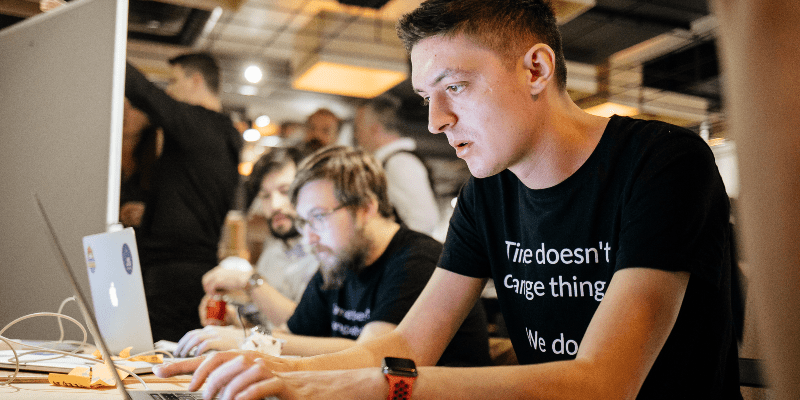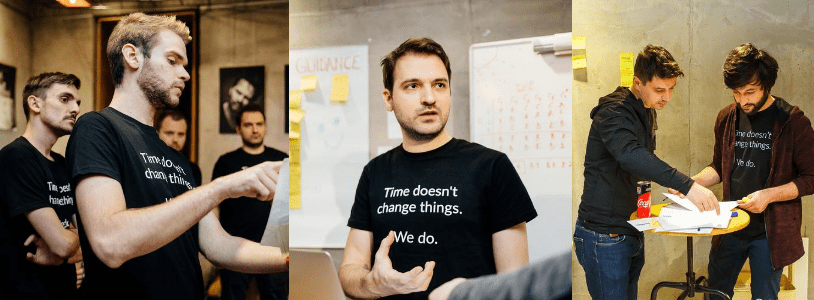In our mission to help businesses navigate complex, changing landscapes and create high-growth digital products at startup speed, we combine Lean principles, Skunkworks practices, and Agile.
Because it’s so different from the traditional ways of working, Agile in particular is often misunderstood and not easily done right. For us, Agile is a powerful way to organize our teams and deliver super fast in all our projects. Agile is enabling us to deliver digital MVPs in 10 weeks. Working this way for over a decade, we’re able to recognize and recommend its benefits from our own experience.
Agile is a mindset – not a methodology, not a method
Before we dive into how Agile is enabling us to build digital products fast, let’s just clarify that Agile is not a methodology or a method. Had it been so, it would have been a step-by-step process of how to achieve something.
Agile is a mindset, or a philosophy if you want, built on a set of 4 values and 12 principles clearly defined in the Agile Manifesto in the early 2000s. In 2001, 17 software engineers got together at a snowboard ski resort in Utah and defined 12 principles that became the bedrock of Agile in software development.
Still, Agile doesn’t equal software development. Skim through the Agile principles, and you can easily notice that they apply to any business environment. Satisfy customers through early and continuous delivery of valuable work. Build projects around motivated individuals. Keep it simple. Welcome changing requirements even late in the project. Aren’t these principles valid in any field?
Agile is about small teams working fast, going autonomous, and doing amazing things in a short amount of time. Although it’s traditionally thought for the product building stage, Agile is such a clear, simple, effective way of working that it creates tremendous value in other product stages as well – insights, rapid prototyping, post-launch, etc. Check out what we appreciate most in being Agile.
#1 Agile is super disciplined
Agile is all about discipline. Once you’ve defined what the big work is – i.e. what creates the greatest value for the client, you break it into smaller tasks that can be easily managed and completed fast.
Self-organizing teams generate most value, and leaders don’t get in the way. When you’re working with autonomous people, there’s no room for micromanagement. As a leader, your responsibility is to provide your team with the environment and the support they need – give them time and space, all the underlying conditions to do great work, trust them to get the job done, and get out of the way. Remove everything that slows people down, bureaucracy, steering committees, etc.
The great thing about Agile is that it comes with flows, tools, and practices that allow teams to be super nimble, adaptive, fast-moving, and iterative.

Q development team doing sprint work
For instance, the product backlog helps you prioritize work derived from the roadmap and the highest priorities are at the top. This way the team always knows what needs to be delivered first. Priorities are then distributed across time-boxed periods, i.e. sprints, which stretch over 2 up to 4 weeks.
With tools such as Confluence and Jira, you cover product thinking, context, ideas, and workflow management. While Confluence works like a rich knowledge capture and documentation tool, Jira helps you organize all the work that needs to be done and organize the backlog into sprints
#2 Agile is all about clear roles
Agile organizations keep the hierarchy as flat as possible. This empowers people to work autonomously, make decisions, and take ownership. This is why Agile teams are able to self-organize and deliver fast.
With Scrum, one of most popular Agile frameworks for software development, the team has a very clear structure.
Product Owner
He/She is focused on the backlog, defining what the users desire, what is feasible, what is viable. He/She is the one who drives things forward relentlessly, while staying open and comfortable with uncertainty. His/her job is to create clarity, while managing feedback, stakeholders and releases.
Scrum Master
He/She sticks to the plan and gets blockers out of the way. Super-organized and flexible, the scrum master is in fact the new project manager, who pays attention to the team, knows when people are exhausted or when they need to grow the pace. He/she masters communication, balances logic and creativity, and values transparency.
The Development Team
This multidisciplinary team is the core engine of the project – UX designers, UI designers, BAs, developers, data scientists, etc. They work autonomously and interface a lot with the scrum master and the product owner.
#3 Agile is predictable
Agile teams don’t have to put deadlines on every single task. Nor do they need to do documentation just for the sake of having it. The time they’d waste on non-essential mechanics such as these has better use in doing the actual work. Because one of the team’s key goals is to deliver valuable work continuously.
With Agile, plans can be adjusted multiple times, but that doesn’t mean postponing delivery. The key goal is to invest time in planning at the best possible moment and adjust the changes easily.
One of the Agile principles encourages teams to value individuals and interactions over tools and processes. Just like many other Agile-driven methodologies, Scrum empowers people to do the work and focus on delivery through frequent interactions.

Agile interactions at Q
Scrums
Everyone meets for daily stand-ups of 30 minutes max. Scrum is not about reporting on the work done. It’s about confirming whether you’re on track or not, and sharing any blockers. That way you can get help fast.
Demos
The core team demoes before the braintrust in sessions of maximum 90 minutes. It’s when you share what you’re learning and what you’re doing next. Should happen every 2 weeks or so – if you demo more often, you won’t have much time left for work.
Monthly/Bimonthly showcase
The core team reunites with the braintrust & interested/relevant stakeholders to get people to see the work. This happens especially in large organizations. It’s a great opportunity to share what you’ve learned and what you achieved, and get advice from the experts across the organization.
Sprint retrospective
Should happen at the end of every sprint. It’s when everybody shares what went well and what could have been done better. It’s also an opportunity to define what the team is going to commit to for the next spring. Retrospectives are necessary because they help you give more realistic estimates, get better quality and learn from peer reviews.
Agile’s been around for a while
Agile is mostly a state of mind. It’s a way of being and doing. For many it’s a modern approach, but history shows us that Agile has been around long before 2001.
In 1943, Lockheed Aircraft Corporation built the first high-speed fighter jet for the US Army under a 180-day deadline and compelling project constraints. Based on principles that echo the Agile Manifesto ahead of time, Lockheed viciously minimized the team, delivered early and continuously, documented their work but not every step and handed over the world-class aircraft – XP-80 Shooting Star – 37 days sooner than expected.
Back to the present, even with automotive lines where methodologies and processes are traditionally set in stone, Agile enables continuous progress at great speed. Tesla teams for instance make around 20 engineering changes every week to improve the production and performance of the Model S.
The advantages of being and working Agile proves yet again that Lockheed Martin’s Chief Engineer Clarence “Kelly” Johnson was right in saying that “we are not defined by the technology that we create, but by the process in which we create them.”
To learn how to organize your team and enable them to get as much output as fast as possible, subscribe to our BottomUp Skills free e-learning platform for busy innovators, makers and creatives. In an end-to-end Agile Masterclass, our CEO Mike Parsons will teach you to create high-performance product teams and give you practical advice on how to design and develop products faster.
About BottomUp Skills
BottomUp Skills is the e-learning platform created and supported by the QUALITANCE global thought-leadership team for innovators, makers, and creatives who want to sharpen their skills in innovation, design thinking, and technology. Usually, such courses are exclusive to our clients such as Ford Motor Company, News Corp Australia, Breville, and many others around the world. Now, we have opened the paid subscription courses and made them available to everyone for life.



TOP 6 product development tools & techniques to make your own in 2022 - QUALITANCE
Posted at 17:05h, 19 January[…] to know how the Agile methodology helps us deliver fast and flawlessly? ? Find out more in this […]